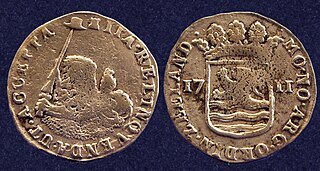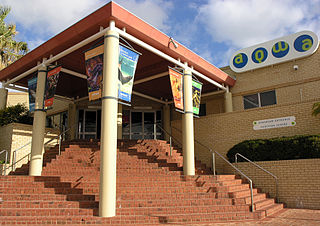Related Research Articles

Batavia was a ship of the Dutch East India Company (VOC). Built in Amsterdam in 1628 as the company's new flagship, she sailed that year on her maiden voyage for Batavia, capital of the Dutch East Indies. On 4 June 1629, Batavia was wrecked on the Houtman Abrolhos, a chain of small islands off the western coast of Australia.

The Houtman Abrolhos is a chain of 122 islands and associated coral reefs, in the Indian Ocean off the west coast of Australia, about 80 km (50 mi) west of Geraldton, Western Australia. It is the southernmost true coral reef in the Indian Ocean, and one of the highest latitude reef systems in the world. It is one of the world's most important seabird breeding sites, and is the centre of Western Australia's largest single-species fishery, the western rock lobster fishery. It has a small seasonal population of fishermen, and a limited number of tourists are permitted for day trips, but most of the land area is off limits as conservation habitat. It is well known as the site of numerous shipwrecks, the most famous being two Dutch ships: Batavia, which was wrecked in 1629, and Zeewijk, wrecked in 1727.

Broome, also known as Rubibi by the Yawuru people, is a coastal pearling and tourist town in the Kimberley region of Western Australia, 2,046 km (1,271 mi) north of Perth. The town recorded a population of 14,660 in the 2021 census. It is the largest town in the Kimberley region.

Zuytdorp, also Zuiddorp was an 18th-century trading ship of the Dutch East India Company.
The Vergulde Draeck, also spelled Vergulde Draak and Vergulde Draek, was a 41.8-metre (137 ft), 260-tonne (290-ton) ship constructed in 1653 by the Dutch East India Company.

The Aquarium of Western Australia (AQWA) is a privately owned aquarium in Hillarys, Western Australia. AQWA was Australia's largest aquarium when it opened and still possesses Australia's largest single aquarium and walk-through underwater tunnel.
Ron Josiah Taylor, AM was a prominent Australian shark expert, as is his widow, Valerie Taylor. They were credited with being pioneers in several areas, including being the first people to film great white sharks without the protection of a cage. Their expertise has been called upon for films such as Jaws, Orca and Sky Pirates.
The Zeewijk was an 18th-century East Indiaman of the Dutch East India Company that was shipwrecked at the Houtman Abrolhos, off the coast of Western Australia, on 9 June 1727. The survivors built a second ship, the Sloepie, enabling 82 out of the initial crew of 208 to reach their initial destination of Batavia on 30 April 1728. Since the 19th century many objects were found near the wreck site, which are now in the Western Australian Museum. The shipwreck itself was found in 1968 by divers.
Over 1400 ships have been wrecked on the coast of Western Australia. This relatively large number of shipwrecks is due to a number of factors, including:
Tryall was a British East India Company-owned East Indiaman launched in 1621. She was under the command of John Brooke when she was wrecked on the Tryal Rocks off the north-west coast of Western Australia in 1622. Her crew were the first Englishmen to sight or land on Australia. The wreck is Australia's oldest known shipwreck.

Pearling in Western Australia includes the harvesting and farming of both pearls and pearl shells along the north-western coast of Western Australia.

Michael Hatcher is a British explorer and marine salvor.

The Pelsaert Group is the southernmost of the three groups of islands that make up the Houtman Abrolhos island chain. it consists of a number of islands, the largest of which are Gun Island, Middle Island, and Pelsaert Island. The group is named after a Dutch "opperkoopman" who stranded nearby with the VOC-ship "Batavia" in 1629. The group contains the most southerly true coral reefs in the Indian Ocean. The group is part of the Houtman Abrolhos Important Bird Area, identified as such by BirdLife International because of its importance for supporting large numbers of breeding seabirds.

Gun Island is one of the larger islands in the Pelsaert Group of the Houtman Abrolhos, in the Indian Ocean off the west coast of Australia. It is nominally at 28°53′10″S113°51′35″E, about 4 km (2.5 mi) north and east of Half Moon Reef and is a flat limestone outcrop of about 800 by 420 metres in size. The island is part of the Houtman Abrolhos Important Bird Area, identified as such by BirdLife International because of its importance for supporting large numbers of breeding seabirds.
Batavia Road is an anchorage, or roadstead, in the Pelsaert Group of the Houtman Abrolhos, off the coast of Western Australia. It is located at 28°58′S113°58′E, on the eastern side of Pelsaert Island, near its southern end. It was discovered and named in April 1840 by John Clements Wickham, captain of HMS Beagle. Wickham's assistant John Lort Stokes later wrote:
"On the south west point of the island the beams of a large vessel were discovered, and as the crew of the Zeewyk, lost in 1728 [sic], reported having seen the wreck of a ship on this part, there is little doubt that the remains were those of the Batavia, Commodore Pelsart, lost in 1627. We in consequence named our temporary anchorage Batavia Road, and the whole group Pelsart Group."
Lady Elliot was a ship that was probably wrecked off the coast near Cardwell, Queensland, Australia in 1816. It was a ship of 353 tons and had been constructed in Bengal, India, completed in 1815.

Wiebbe Hayes was a Dutch soldier known for his leading role in the suppression of Jeronimus Cornelisz's massacre of shipwreck survivors in 1629, after the merchant ship Batavia was wrecked in the Houtman Abrolhos, a chain of coral islands off the west coast of Australia.

Max Cramer OAM was an Australian scuba diver who became famous as the co-discoverer of the wreck of the Batavia on 4 June 1963. He was involved in a number of maritime archaeology projects pertaining to historic shipwrecks in Western Australia.
Islands of Angry Ghosts is a 1966 book by Australian journalist and writer Hugh Edwards. The book is split into two parts: the first reconstructs the wreck and subsequent horrors, including mutiny, murder, rape and cannibalism, associated with the wreck of the Dutch East India Company's Batavia of the Western Coast of Australia; and the second follows the search for the wreck and salvage of the wreck by Edwards and a crew of divers.
Beacon Island, also known as Batavia's graveyard, is an island on the eastern side of the Wallabi Group at the northern end of the Houtman Abrolhos, in the Indian Ocean, off the coast of Western Australia.
References
- ↑ "Treasure from the sea". The Canberra Times . Vol. 37, no. 10, 622. Australian Capital Territory, Australia. 23 August 1963. p. 13. Retrieved 25 February 2021– via National Library of Australia.
- ↑ Western Australia Legislative Assembly 17 August 1994 Select Committee on Ancient Shipwrecks
- ↑ National Centre for History Education Archived 5 March 2016 at the Wayback Machine The Batavia and Her Detectives